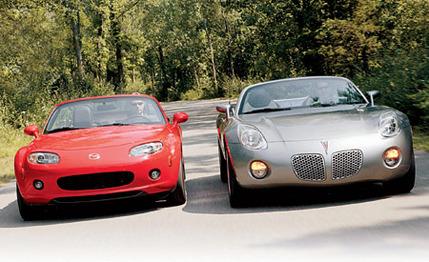 Road Test
Road Test
It took some wrangling, but we got a Pontiac Solstice and a Mazda MX-5 together for a day. It wasn't enough time for a traditional comparison test, which can exhaust the better part of a week, but it was enough time to draw some conclusions in nine purely subjective (touchy-feely) categories crucial to roadster enjoyment.
Exterior: Park the Mazda next to the Pontiac, and the show-car-like American two-seater is the one that will draw a crowd. The Solstice has the advantage of a brand-new shape, wheels at the corners, and bulges in all the right places. The MX-5 isn't styled as radically as the Solstice, but it does look lighter and more agile. Advantage: Solstice.
Interior: Like the exterior, the interior of the MX-5 is a fresh interpretation of the previous-generation car. For the most part, the fit and finish of the Mazda is better than the Solstice's. The Solstice has generally mediocre interior plastic, but the classy instrument surround almost makes up for that. Both roadsters have tilting steering columns (neither telescopes), but the Mazda's moves higher to clear the view of the instruments. Also, the Mazda doesn't lock you in until you remove the key. Advantage: MX-5.
Top operation: Neither has a power top, but the MX-5's can be raised or lowered from the driver seat. It's easy to operate the Solstice's top, but you do have to get out. Advantage: MX-5.
Practicality: The MX-5 has a weekend-trip-friendly trunk that doesn't lose capacity when the top is down. When the Solstice's top comes down and competes for space, the trunk goes from minute to minuscule. Inside, both have similar storage spaces, and the Solstice has handy pockets in the front of the seats. Advantage: MX-5.
Ride: On rough roads, the MX-5 feels as if it has softer springs and more wheel travel than the Solstice. The MX-5 feels wispy and light on its feet, but the Solstice's stiffer suspension still manages to sop up the bumps while feeling more planted. Advantage: Solstice.
Handling: Both have handling limits that are substantial yet easy to probe. Approach the limits in the MX-5, and the softer suspension never quite settles down. The light-footed ride gives the MX-5 a delicate character. The Solstice trades that featheriness for a secure, buttoned-down feel at the limit. Comparatively narrow summer tires on the MX-5 stick and then break away; the Solstice's wider all-season rubber loses grip more gradually. Advantage: Solstice.
Structure: It takes a lot to get either roadster to shake, but the heavier Solstice feels a little stiffer. Advantage: Solstice.
Primary controls: The shifter in the MX-5 doesn't go easily into gear when cold; once warm, its short throws and directness are superior to the Solstice's good but unremarkable gearbox. Brake-pedal feel is similar in both cars: no lost motion and easy to modulate. We preferred the turn-in feel of the Solstice's steering-nicely weighted and precise. The MX-5's gets you close to the contact patches, but excessive kickback over bad roads gets annoying. Advantage: Draw.
Engine: The MX-5 sounds wimpy at idle but builds revs quickly and sounds happier as the revs increase. The Solstice idles better and barks louder, but the engine feels as if it has a heavier flywheel, and it buzzes more than we like. Nevertheless, the growling Solstice sounds better. Advantage: Draw.
THE VERDICT
The frenetic and lightweight MX-5 is a single-minded sports car. The heavier Solstice has two personalities: cruiser and sports car-it excels at both. In this purely subjective evaluation, the Solstice scores higher. When we do a formal and objective comparison, the result might change. But we'd say the General has won this skirmish.